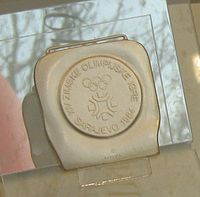1984 to 1998
Sapporo, Japan and Gothenburg, Sweden, were front-runners to host the 1984 Winter Olympics. It was therefore a surprise when Sarajevo, Yugoslavia, was selected as host.[46] The Games were well-organised and displayed no indication of the war that would engulf the country eight years later.[47] A total of 49 nations and 1,272 athletes participated in 39 events. Host nation Yugoslavia won its first Olympic medal when alpine skier Jure Franko won a silver in the giant slalom. Another sporting highlight was the free dance performance of British ice dancers Jayne Torvill and Christopher Dean. Their performance to Ravel's Bolero earned the pair the gold medal after achieving unanimous perfect scores for artistic impression.[47] In 1988, the Canadian city of Calgary hosted the first Winter Olympics to span 16 days.[48] New events were added: ski-jumping and speed skating; while future Olympic sports curling, short track speed skating and freestyle skiing made their appearance as demonstration sports. For the first time the speed skating events were held indoors, on the Olympic Oval. Dutch skater Yvonne van Gennip won three gold medals and set two world records, beating skaters from the favoured East German team in every race.[49] Her medal total was equalled by Finnish ski jumper Matti Nykanen, who won all three events in his sport. Alberto Tomba, an Italian skier, made his Olympic debut by wi

ning both the giant slalom and slalom. East German Christa Rothenburger won the women's 1,000 metre speed skating event. Seven months later she would earn a silver in track cycling at the Summer Games in Seoul, to become the only athlete to win medals in both a Summer and Winter Olympics in the same year.[48] The 1992 Games were the last to be held in the same year as the Summer Games.[50] They were hosted in the French Savoie region in the city of Albertville, though only 18 events were held in the city. The rest of the events were spread out over the Savoie.[50] Political changes of the time were reflected in the Olympic teams appearing in France: this was the first Games to be held after the fall of Communism and the dismantling of the Berlin Wall and Germany competed as a single nation for the first time since the 1964 Games; former Yugoslavian republics Croatia and Slovenia made their debuts as independent nations; most of the former Soviet republics still competed as a single team known as the Unified Team, but the Baltic States made independent appearances for the first time since before World War II.[51] At 16 years old, Finnish ski jumper Toni Nieminen made history by becoming the youngest male Winter Olympic champion.[52] New Zealand skier Annelise Coberger became the first Winter Olympic medallist from the southern hemisphere when she won a silver medal in the women's slalom.